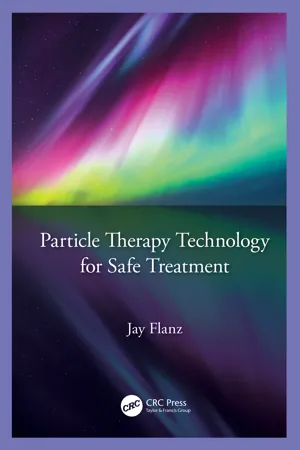
- 388 pages
- English
- ePUB (mobile friendly)
- Available on iOS & Android
Particle Therapy Technology for Safe Treatment
About this book
The path from clinical requirements to technical implementation is filtered by the translation of the modality to the technology. An important part of that filter is that the modality be safe. For that to be the case, it is imperative to understand what clinical parameters affect the safety of a treatment and then determine how the technology can affect those parameters.
This book provides a practical introduction to particle therapy. It provides a thorough introduction to the technological tools and their applications and then details the components that are needed to implement them. It explains the foundations of beam production and beam delivery that serve to meet the necessary clinical requirements. It emphasizes the relationship between requirements and implementation, including how safety and quality are considered and implemented in the solution. The reader will learn to better understand what parameters are important to achieve these goals.
Particle Therapy Technology for Safe Treatment will be a useful resource for professionals in the field of particle therapy in addition to biomedical engineers and practitioners in the field of beam physics. It can also be used as a textbook for graduate medical physics and beam physics courses.
Key Features
- Presents a practical and accessible journey from application requirements to technical solutions
- Provides a pedagogic treatment of the underlying technology
- Describes how safety is to be considered in the application of this technology and how safety and quality can be factored into the overall system
Author Bio
After receiving his PhD in nuclear physics, Dr. Jacob Flanz was the Accelerator Physics Group leader and Principal Research Scientist at the Massachusetts Institute of Technology (MIT), USA, where he designed the recirculator and the GeV stretcher/storage ring. He joined Massachusetts General Hospital (MGH) and Harvard and became project and technical director of proton therapy, with responsibility for specifications, integration, and commissioning ensuring safe clinical performance. He invented the universal nozzle and led the design and implementation of beam scanning at MGH in 2008, including quality assurance. Dr. Flanz has been involved in several FDA applications for particle therapy. He developed and taught the US Particle Accelerator School course "Medical Applications of Accelerators and Beams." He was cochair of education and is currently the president of the Particle Therapy Co-Operative Group.
Exercise solutions to accompany this book can be accessed via the 'Instructor Resources' tab on the book webpage.
Frequently asked questions
- Essential is ideal for learners and professionals who enjoy exploring a wide range of subjects. Access the Essential Library with 800,000+ trusted titles and best-sellers across business, personal growth, and the humanities. Includes unlimited reading time and Standard Read Aloud voice.
- Complete: Perfect for advanced learners and researchers needing full, unrestricted access. Unlock 1.4M+ books across hundreds of subjects, including academic and specialized titles. The Complete Plan also includes advanced features like Premium Read Aloud and Research Assistant.
Please note we cannot support devices running on iOS 13 and Android 7 or earlier. Learn more about using the app.
Information
1Introduction
2Evolution of Medical Particles
- Magnetic fields
- High frequencies
- X-rays
- Electrons
- Protons
- Lasers
Table of contents
- Cover Page
- Half Title Page
- Title Page
- Copyright Page
- Dedication Page
- Contents
- Chapter 1 Introduction
- Chapter 2 Evolution of Medical Particles
- Chapter 3 A Personal Historical Perspective
- Chapter 4 Flow of Requirements
- Chapter 5 External Beam Systems
- Chapter 6 How to Damage Unwanted Cells
- Chapter 7 Exponentials
- Chapter 8 Relativistic Dynamics
- Chapter 9 Charged Particle Interactions in Matter
- Chapter 10 Review of Charged Particle Motion
- Chapter 11 Clinical Perspective of Charged Particle Therapy Beams
- Chapter 12 Three-Dimensional Dose Conformation
- Chapter 13 Accelerator Systems
- Chapter 14 Gantries
- Chapter 15 Safety in Radiotherapy
- Chapter 16 Sensitivities and Tolerances: Scattering
- Chapter 17 From Clinical to Technical Tolerances: Scanning
- Chapter 18 Afterword
- Acknowledgments
- Appendix A: Particle Therapy Facilities (as of June 2021)
- Appendix B: Some Useful Constants
- Appendix C: Hazard Topics
- Appendix D: Beam QA Frequency Possibility
- Appendix E: Some Element and Compound Parameters
- Index